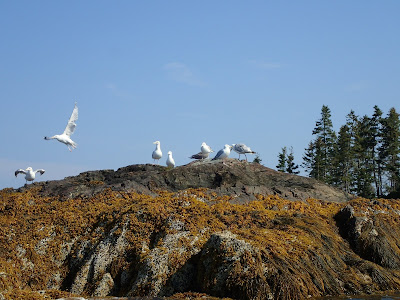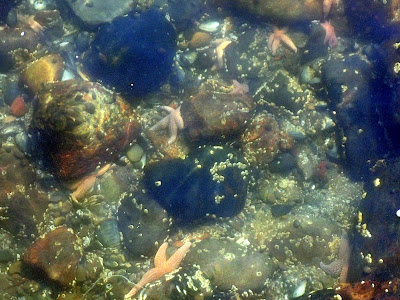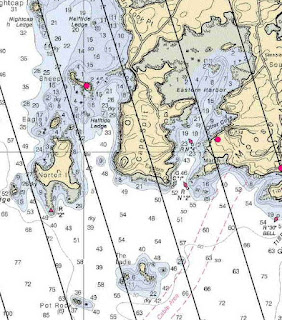Today's post was supposed to be pictures of the Porcupine Islands, probably my favorite place to paddle. We haven't been there all summer, for many reasons. One is that, to get there we need to go to Bar Harbor, which is a zoo all summer long. Another is a longer story.
Mark's tendinitis, which bothered him most of last year, has been more pronounced this year, so most longer kayak trips have been impractical. We've done more short paddle board trips, which seem to bother his elbow less, and I've done lots of trips on the river.
And not much has happened on the river. For a few weeks there was a seal pup hanging out, but no good could come from sharing that sighting, and other than that it's been the usual eagles, seagulls, ducks and crows.
 |
| Could you give away his location? |
He started playing one day a week, but quickly ramped up to a five day a week program. Then he began encouraging me to come along. "Anyone can play!" he claimed, "You can play at any level."
 |
| Ledges near Ram Island |
And so, one day I found myself on the court. "Just lob the ball over the net," he coached. So I did. In short order, my opponent (not Mark) slammed the ball back. It crashed into my knee at 40 mph.
"Anyone can play" but not anyone can play well. Mark has an advantage, having played ping pong for many years. Other pickleball players come from tennis, racketball or squash backgrounds. I hadn't done any of those, though I had played badminton as a kid. (in our neighborhood we used a volleyball net to play, I was utterly shocked when my kids started playing to discover the net was only supposed to be 5 feet high - none of my skills seemed to translate to this new net.)
There are generally four players to each game. In the non-competitive practice I went to, a game lasted about 15 minutes, and the players got switched around after. For a beginner, that's good news, because the people playing with you aren't stuck losing all night.
Pickleball is known as a social sport, after each game we get to chat. And the court is small enough that that we can talk during the game. There's a lot of support at the game, from hints on playing better, to congratulations on a good shot. I think I got my first congratulations when using the paddle to block my face, resulting in the ball actually going back over the net. Then there are "Good games" all around at the end.
Mark, as it turns out, is pretty good at pickleball. They call him "The Wall", as in "No one gets past The Wall." They call me "The Sieve."
There are many good things about pickleball. It is social, if you don't want to play the same game all the time, you have to find new people. One day a group of woman came down from Grand Manan Island seeking new opponents (victims). It helps us exercise, and lose weight. We lose weight primarily because we can't eat before we play, if we have any hope of moving fast enough to get the ball. And, once we're done, what we crave more than food is water, more water, and icy water.
So, in addition to working around work schedules, and planning shorter kayaks trips, we've also been working around pickleball. Today, Labor Day was supposed to be reserved for a trip to the Porcupines. Then a few weeks ago, a pickleball tournament was announced for Saturday. Mark was quickly snapped up for a men's double team. And eventually, someone convinced me to be their partner. Mark's team came in second. Ours didn't place quite that high. But even with the tournament, we were going to save today for the Porcupine trip.
Sunday, Mark and I found ourselves paddling on the Penobscot. Mark had pulled a few muscles in his games, but he felt sure he could do a Porcupine run. "I'll just stay away from rock gardening and bracing."
It can be hard to resist the lure of popping into keyholes, but it's certainly possible. But, I'm not sure I could guarantee that Mark wouldn't have to brace. I can't control the weather, or the wind. I can't promise there wouldn't be confusing waves. Especially not if we were going by the cliffs, and if we weren't going by the cliffs was it really worth it to face the Bar Harbor mobs?
So instead we went to Castine, where the harbor and islands interact to protect the water and assure there's probably a calm route back to the launch. Because making sure the water is within your capabilities is something you need to determine before you find yourself 3 or 4 miles offshore.
And to tell the truth, it was a wonderful time in Castine, with some amazing scenery; it is hard to imagine a better day!
The seal pup picture was taken on the Penobscot River in the spring, the rest were from Castine, today.
Details for trip planning can be found in earlier posts
Some prior Castine Trips: Halloween Tour, Best Laid Plans, We do have a plan (Castine is apparently our top choice for plan related blog posts)
Some Porcupine Trips: Porcupines Again, Porcupines Islands in Late September, Seven Reasons to visit the Porcupines.


























































